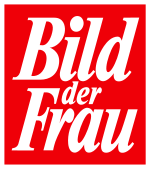Bild der Frau
Bild der Frau is a German language weekly women's magazine published in Hamburg, Germany that has been in circulation since 1983.
 Logo of Bild der Frau | |
| Editor-in-chief | Sandra Immoor |
|---|---|
| Categories | Women's magazine |
| Frequency | Weekly |
| Circulation | 777,050 (Q2 2016) |
| First issue | 1 March 1983 |
| Company | Funke Mediengruppe |
| Country | Germany |
| Based in | Hamburg |
| Language | German |
| Website | Bild der Frau |
| ISSN | 0949-6874 |
History and profile
Bild der Frau was established in March 1983.[1][2][3] The headquarters of the weekly is in Hamburg.[4][5] The magazine was part of the Axel Springer Group[2][6] and was published by Axel Springer SE on a weekly basis.[4] In July 2013 the Axel Springer Group sold it and many other publications to Funke Mediengruppe.[7][8]
Bild der Frau is a full-color tabloid magazine which features articles related to women-related topics.[9] Sandra Immoor is the editor-in-chief of the magazine[10] of which the website was started in 2001.[11]
Circulation
In 1987 Bild der Frau sold 2.5 million copies.[1] During the third quarter of 1992 the magazine had a circulation of 2,094,000 copies.[12] The circulation of the weekly was 2,108,309 copies between October and December 1994.[13] Its 1999 circulation was 1,977,300 copies.[14]
During the fourth quarter of 2000 the circulation of the weekly was 1,662,502 copies.[15] In 2001 it was the eleventh best-selling women's magazine worldwide with a circulation of 1,663,000 copies.[16] The magazine had an average circulation of 1,186,000 copies in 2003.[17] In the fourth quarter of 2006 its circulation was 1,083,300 copies.[17] It rose to 1,478,000 copies for 2006 as a whole.[18]
Bild der Frau sold 1,085,258 copies during the second quarter of 2007.[19] The magazine had a circulation of 1,021,098 copies in 2009, making it the best-selling weekly women magazine in Europe.[20] In 2012 the circulation of the magazine was 897,600 copies.[21] During the second quarter of 2016 the magazine had a circulation of 777,050 copies, making it the best-selling women's magazine in the country.[22]
See also
References
- Karl Koch (17 December 2014). West Germany Today (RLE: German Politics). Taylor & Francis. p. 145. ISBN 978-1-317-53648-2. Retrieved 29 March 2015.
- "auFeminin.com relaunches the site Bildderfrau.de in Germany" (PDF). aufeminin. Paris. 14 January 2010. Archived from the original (Press Release) on 2 April 2015. Retrieved 29 March 2015.
- "International Licensing 2012/2013" (PDF). Axel Springer. Archived from the original (PDF) on 20 January 2014. Retrieved 29 March 2015.
- "Factsheet". Publicitas. Archived from the original on 2 April 2015. Retrieved 29 March 2015.
- Western Europe 2003. Psychology Press. 30 November 2002. p. 294. ISBN 978-1-85743-152-0.
- Anthony Weymouth; Bernard Lamizet (3 June 2014). Markets and Myths: Forces For Change In the European Media. Taylor & Francis. p. 206. ISBN 978-1-317-88969-4.
- Stefan Schultz; Vanessa Steinmetz; Christian Teevs (26 July 2013). "Sell-Off: Newspaper Giant Turns Back on Journalism". Der Spiegel. Retrieved 29 March 2015.
- "Establishment of joint ventures for advertising marketing and distribution" (Press Release). Axel Springer. 25 July 2013. Retrieved 29 March 2015.
- Dick Hendrikse (September 1986). "Illiteracy: Threat to European Magazines?". Folio: the Magazine for Magazine Management. 15. Retrieved 31 March 2015. – via Questia (subscription required)
- "Affirmative Action: SPD Women Want Gender Quota from Merkel". Der Spiegel. 1 October 2013. Retrieved 12 May 2015.
- Ulrich Kaiser (1 August 2002). "Optimal Cover Prices and the Effects of Website Provision on Advertising and Magazine Demand" (Discussion paper). Centre for European Economic Research. Retrieved 30 March 2015.
- Georg Hellack (1992). "Press, Radio and Television in the Federal Republic of Germany" (Report). Inter Nationes. Retrieved 4 April 2015.
- "Top paid-circulation consumer magazines". Ad Age. 17 April 1995. Retrieved 29 March 2015.
- Ingomar Kloss; M. Abe (1 January 2001). Advertising Worldwide: Advertising Conditions in Selected Countries. Springer Science & Business Media. p. 130. ISBN 978-3-540-67713-0.
- Fiona Jebb (13 April 2001). "Campaign report on Germany". Campaign. Retrieved 30 March 2015.
- "Top 50 Women's magazines worldwide (by circulation) 2001" (PDF). Magazines. Archived from the original (PDF) on 2 April 2015. Retrieved 30 March 2015.
- "European Publishing Monitor" (PDF). Turku School of Economics (Media Group). March 2007. Archived from the original (Report) on 10 October 2017. Retrieved 27 March 2015.
- Helmut K Anheier; Yudhishthir Raj Isar (17 September 2008). Cultures and Globalization: The Cultural Economy. SAGE Publications. p. 460. ISBN 978-1-4462-0261-6.
- Jochen Beckmann; Stephan Zech (17 September 2007). "TV listings – How to grow in mature markets" (PDF). Axel Springer. Berlin. Archived from the original (PDF) on 21 December 2016. Retrieved 5 June 2016.
- "World Magazine Trends 2010/2011" (PDF). FIPP. Archived from the original (PDF) on 2 April 2015. Retrieved 4 April 2015.
- "Annual Report 2012" (PDF). Axel Springer AG. Archived from the original (PDF) on 5 March 2016. Retrieved 30 March 2015.
- "Advertising rates Magazines 2016". Media Impact. Archived from the original on 31 January 2016. Retrieved 18 September 2016.